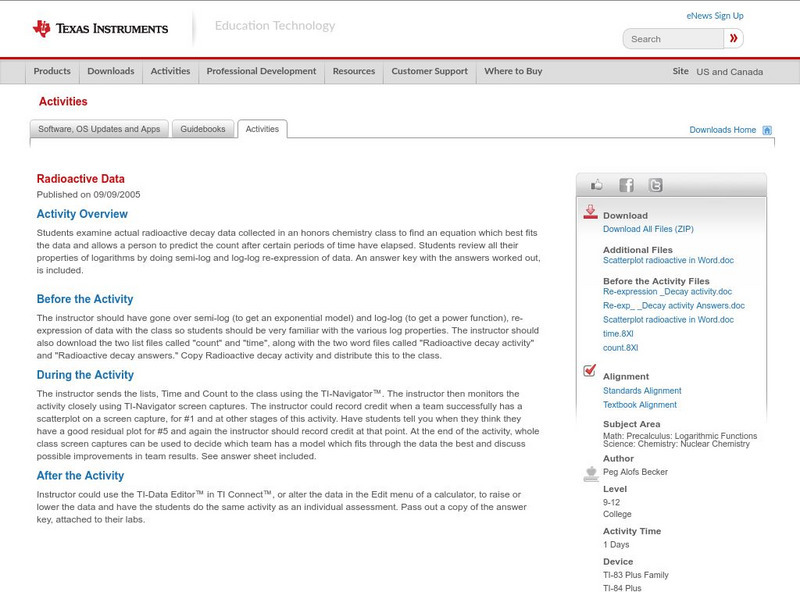Hi, what do you want to do?
NOAA
The Oceanographic Yo-yo
How does chemistry help deep-sea explorers? Part four of a five-part series of lessons from aboard the Okeanos Explorer introduces middle school scientists to technologies used in ocean exploration. Groups work together to analyze data...
NASA
Exploration of a Problem: Making Sense of the Elements
When given too much data to simply memorize, it helps to sort it into manageable groups. The second lesson in the six-part series of Cosmic Chemistry challenges groups of pupils to take a large amount of data and figure out how to best...
University of Georgia
Splat!
What does viscosity have to do with splatter? An activity shows that the viscosity of a substance is inversely proportional to the distance of its splatter. Learners conduct the experiment by collecting data, graphing, and analyzing...
NASA
Connecting Models and Critical Questions
Scholars use data to analyze and determine which sets of information need to be counted. They create a model to explain differences among chemical elements using graphs to prove concept mastery.
Curated OER
Determination of An Acid Dissociation
In this chemistry worksheet, students examine the given concept in order to apply in the laboratory setting. The sheet includes in depth background information.
Curated OER
CSI: Chemistry Student Investigators
Students study chemistry. In this laboratory lesson students watch the CSI episodes and investigate their laboratory techniques and discuss what they saw.
Curated OER
Phase Transition Temperature of Fats
In this chemistry worksheet, learners investigate through experimentation the solidifying behavior of some edible fat mixtures by determining their cooling curves. Then they data-log equipment to obtain a large number of temperature...
Curated OER
Bioinformatics
Students conduct a series of scientific investigation using bioinformatics. In this molecular biology instructional activity, students collect experimental data using different educational softwares. They calculate and analyze...
Curated OER
What's Cookin'?
Students examine their eating habits. In this nutrition lesson plan, students will journal their eating habits over a period of three days. They will use a diet analysis web page to determine the nutritional factors of their eating habits.
It's About Time
Mass and Volume
Don't be so dense that light bends around you; study the relationship between mass and volume instead. Young chemists measure the density of a variety of liquids and solids. A reading passage and analysis questions introduce pupils to...
It's About Time
Identifying Matter
High schoolers test wood splints that have been soaked in mystery solutions to identify the different colors it produces when lit. The lesson concludes with a reading passage and analysis questions.
Curated OER
A Whiff of Danger
Public health trainees read and write a summary of the article, "A Whiff of Danger". The article is not available through the link, but can be found on the National Center for Biotechnology Information website. After summarizing,...
Curated OER
Determination of a Rate Law
High schoolers determine the rate law for a chemical reaction. They use graphical techniques in the analysis of experimental data.
Curated OER
Hot Air Balloon Design Lesson Plan
Sixth graders discuss what they know and what they want to know about hot air balloon using a KWL chart. They then use a wide array of materials to design a hot air balloon that will lift successfully in cooperative groups referring to...
Curated OER
ACID RAIN
Eighth graders, in groups, take on the role of either Biologist, Chemist, Health Scientist, or Economist. They complete a webquest in which they must decide what to do about a problem concerning the effects of acid rain. They make a...
Curated OER
Common Words that are Similar in Polish and English
In this foreign language learning exercise, students discover that many Polish words are similar to those in English and the meanings can be guessed. Students read a chart of 220 Polish words and their English translations. Example:...
Texas Instruments
Texas Instruments: Radioactive Data
Students examine actual radioactive decay data collected in an honors chemistry class to find an equation which best fits the data and allows a person to predict the count after certain periods of time have elapsed. Students review all...





















